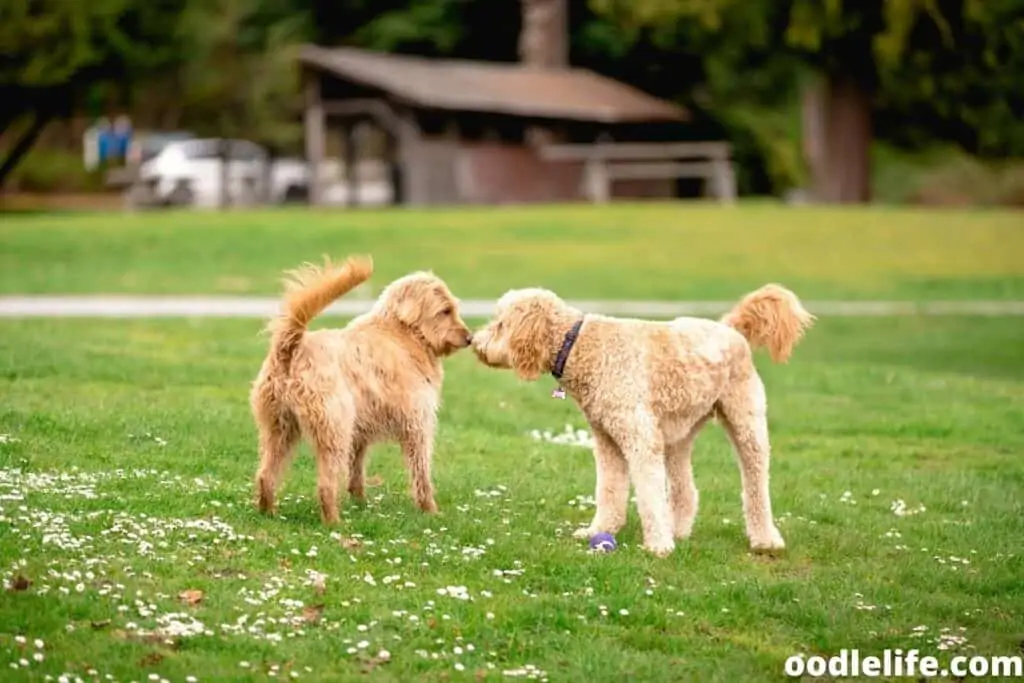Dog Licking Other Dogs Ears (6 Reasons Why)
Dogs indulge in some pretty goofy stuff, which we know is part of their nature. There are many of them, from sniffing butts to learning more about their mates to circling a cage before lying and chasing their tails.

Among the many unusual things my dog does is licking other dogs’ ears, which I find the most fascinating. It’s sometimes a little… disgusting. The first time I noticed it, I expected it to start a fight, but to my surprise, my now-aged dog still loves it when a dog licks his ears.
Why would a dog lick other dogs’ ears? It turns out there are many reasons for this behavior. Some use it as a greeting, while others want to show affection and bond with their companions.
As a dog expert – I get asked about specific dog behavior all the time. You are not alone in wondering why!
TL;DR: Why Dogs Lick Other Dogs’ Ears
- Taste of Wax: Dogs find the bitter, salty taste of earwax appealing, especially if it’s infected, making it irresistible.
- Friendly Greeting: Licking ears is a submissive behavior used as a greeting among pack members, showing friendliness and respect.
- Grooming Help: Dogs lick each other’s ears as part of their grooming process, helping to clean hard-to-reach spots.
- Sign of Affection: Ear licking is a natural behavior that starts from puppyhood, showing affection and bonding between dogs.
It could also be part of their grooming regimen, a sign of compulsive disorder, idleness, or love for earwax.

6 Reasons Dogs Lick Other Dogs’ Ears
1. They Love the Taste of Wax
I have found my dog tasting strange stuff, but earwax seems particularly gross. Besides the funky smell, earwax is bitter and salty. So why would a dog enjoy tasting it?
Apparently, the bitter and salty taste is somewhat savory and tastes even better when the ears have a mild yeast infection. Earwax contains microbes, pollen, dead skin cells, and dirt, which create a bitter and salty taste that dogs love licking.
If the ear is infected, the earwax develops a different smell, taste, and even texture which is more appealing to the dogs. The smell is sometimes likened to Fritos, which makes dog ear-licking almost irresistible.
Another notion behind a dog’s love for earwax is that they crave salt. Like other bodily secretions, earwax contains salt, and licking a dog’s ears satisfies this urge.

2. To Greet Fellow Mates
The behavior is a greeting that dates back to years ago when dogs lived as pack animals. At the time, dominance was an essential part of survival, and a dog was either an alpha pack leader or a submissive follower. This meant dogs exhibited certain traits depending on their respective category. This is also why some dogs lick to nibble or lick human ears.
Ear licking was used to display submissive behavior and greet fellow pack members. It was a sign of friendliness and respect like other appeasement behaviors like lifting paws and avoiding eye contact. The behavior has since trickled down as domesticated dogs still indulge in it.
OodleLife Veterinarian Dr Charlotte Stiles (DVM)
Some dogs dive into the inside of the other dog’s ears immediately while others lick the outer part of the ear, then proceed to the interior as they warm up to each other. I noted that licks used as part of friendly greetings are short, brief, and accompanied by different submissive body language and postures.
3. It’s Part of Grooming
For the longest time, I knew that cats are the only animals that lick themselves clean when grooming, but to my surprise, dogs do it too. While at it, they may need a little help to clean hard-to-reach spots like the ears, and the best way is to allow another dog to lick them.
Although disgusting, the dog getting his ears licked likes the attention that comes with the action. I noticed my dog loves licking other dogs’ ears when lounging with his companions. However, I was keen to examine his ears because excessive licking can lead to ear infections.
Bacteria thrive in moist areas, and the constant licking provides much-needed moisture.

4. Compulsive Behavior
Ear licking may be a sign of a dog’s compulsive disorder. Dogs are fond of licking surfaces, items, and even ears, given their love for earwax. However, it becomes a problem when they compulsively lick the ears.
They may also exhibit other signs of compulsive disorder like circling, freezing and staring, incessant barking, chewing on objects, and flank sucking. It’s best to visit a vet to get help.
5. The Dog Is Too Idle
I also noted my dog indulges in the behavior when he is idle. Boredom causes him to explore new ways of engaging his mind, and licking his friend’s ears might be it. It’s even more appealing when his friend’s ears are infected.
Given his powerful sense of smell, he can identify changes in another dog’s ears, wooing him to start licking.
6. To Bond and Show Affection
The behavior starts earlier on when they are young. It’s the first interaction a dog has with his mom when born. Moms lick puppies when bathing, feeding, and grooming them to bond and show affection.
It’s natural for dogs to carry on with the behavior to show affection to family members when they’re grown. In this case, licking isn’t limited to the ears, but it includes other body parts.

How to Discourage the Behavior?
A little ear-licking is okay, but you must look for ways to discourage it when it’s obsessive and excessive.
First – Rule Out Medical Conditions
The first step is determining if the problem results from a medical condition. Check if the dog has an ear infection, wounds, or other changes that may cause other dogs to lick his ears.

Second – Distract the Dog
If your dog licks his companion’s ears due to idleness, distract him with toys or schedule an activity to keep him busy. I decided to use unique interactive toys which are better than regular ones because they come with treats to keep the dog entertained.
Third – Redirect the Behavior
This option comes in handy for dogs that don’t love toys. You redirect their behavior by issuing commands. I found my dog more receptive to short commands like “stop,” “leave it,” or “don’t do that.”

Fourth – Try Dog Training
Dog training is an excellent way of solving most behavioral problems in dogs. And you can use it, in this case, to discourage your dog from ear licking. It’s particularly effective for dogs that have compulsive or obsessive behavior.
Fifth – Give Them Something Better to Lick
Get him a bone to lick every time you see him licking his companion’s ears. You can also use a lick mat and add some peanut butter. It’s a great way of distracting him and providing him with something to soothe him without creating more problems.

Six – Use Ear Cleaner or Ear Wipes
Brighten up your dog’s day with a quick ear cleaning session! Using ear cleaner or ear wipes not only keeps their ears sparkling but also makes them less tempting for friendly licks from their pals. It’s a simple way to ensure their ears stay fresh, reducing the chance of infections and keeping those curious tongues at bay
- Advanced Formulation Designed to Gently Clean, Deodorize and Dry Your Pets Ears
- Gentle and Safe for Regular Use which Prevents Ear Infections, Reduces Wax Build Up and Removes Debris in and Around the Ear
- For Dogs Over 12 Weeks Old
- Reduce Foul Ear Odor and Prevents Infection to Keeps Your Dog Happy and Healthy without Medication
Read and watch OodleLife's hands on review. We take testing seriously.
- Effective ear cleaning
- Reduces head shaking and scratching
- Pleasant eucalyptus scent
- Easy to use
- Good volume in pack
- Suitable for regular use
- Wipes are small for larger ears.
- May require multiple wipes for thorough cleaning.
- Could be more durable.
Final Thoughts
Ear licking is one of the weirdest ways dogs interact, groom, and communicate health problems. Occasional ear licking is healthy, but if it’s consistent and compulsive, it’s best to identify other reasons for the problem.

